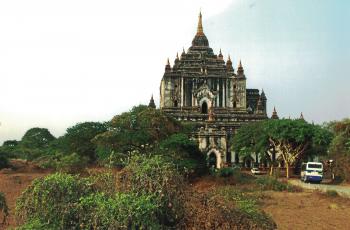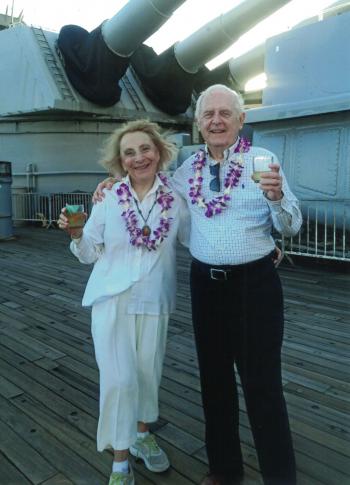Five fabulous events featured on a 180-day ‘round-the-world cruise
This article appears on page 45 of the August 2017 issue.
Over the past few years since my retirement from the Foreign Service, my wife, Lili, and I have cruised around the world several times, taken independent trips to places where ships did not regularly dock and surpassed the “100 mark” of countries and territories visited.
However, we realize that there is still a lot more to see before we finally settle down (if that ever happens).
When we learned that there was a 180-day around-the-world trip offered by Oceania Cruises (Miami, FL; 855/335-2523, oceaniacruises.com) that would add several “firsts” to our travel history, we decided to look into it. (The 2018 Miami-to-Miami cruise departs Jan. 3, with prices starting at $35,699 per person, double occupancy.)
We departed on this extended adventure on Jan. 4, 2016, and cruised aboard the Insignia to places in the world corresponding to every letter of the alphabet (except, perhaps, for the letter “Q,” unless Puerto Quetzal, Guatemala, qualifies). But the five special events provided by the cruise line exclusively for the approximately 200 passengers who completed the entire six months around the world stand out as the highlights of this voyage.
We didn’t know exactly what to expect, but we knew that each event would be very special, and we certainly were not disappointed.
Ancient temples of Bagan
Recently opened to the world at large, and to tourism in particular, the country of Myanmar (formerly Burma) presented some challenges. We knew little about its capital, Yangon (Rangoon), but we soon discovered that, like so many other places in Asia, it was chaotic. Though the city had much to offer, with its monuments, temples and interesting history, it was full of pedestrians, bicycles, motorcycles, carts and older cars, all filling the congested streets and marketplaces.
Plans for our first special excursion, to the ancient city of Bagan, began at 2:45 a.m. on our second day in Myanmar. We made our way through the streets of the awakening city to catch our early flight, but at the airport there was much confusion. No one seemed to be in charge.
The public-address system did not work, and crowds mingled everywhere. In the end, we missed our flight.
Our group eventually boarded a propeller-driven plane headed for the ancient city, the site of more than 2,000 temples and pagodas. We had a smooth flight and arrived in the midday tropical heat of what appeared to be a world that time had somehow forgotten.
We initially settled at the Bagan Lodge in a group of first-class, air-conditioned duplex bungalows that could be found throughout the hotel’s manicured grounds. Then a horse and buggy took us through the area to see some of the many monuments.
The two of us and the driver rode in a flimsy cart pulled by a lean horse over rutted dirt roads — not something I would recommend for anyone with a bad back, but it was fun.
We soon switched to comfortable buses that took us throughout the vast, eerily quiet landscape dotted with ancient temples and stupas, most of which were made of red brick and many in need of repair. (An earthquake that took place after our visit further damaged buildings in the same area.)
We spent a good while walking about, taking photographs and even climbing up one of the higher and more stable temples to watch the sun set over this world of make-believe.
To finish off the day, the lodge prepared a delicious buffet for us, served poolside under a full moon. It would be hard to ask for more.
Very early the next morning, our flight returned us to the realities of the hustle and bustle of tropical Yangon.
Hanoi experience
The second of our special events was an overnight trip to the city of Hanoi from the port of Ha Long Bay, Vietnam. After a 4-hour bus ride through small towns, green rice paddies and traffic (which no one anywhere in the world seems able to escape these days), we finally arrived rather exhausted in the historical capital city.
After quickly registering at the Korean-financed Daewoo Hotel, we were immediately escorted to a water puppet show, followed by a dinner that went late into the night.
What we really needed was a good night’s sleep after such a long ride from the port.
For us, our trip to Hanoi had two priorities: a visit to the infamous Hanoi Hilton (Ho´a Lò Prison) and a view of Ho Chi Minh Mausoleum.
Even after a few hours in this northern part of Vietnam, Lili and I, who had previously traveled through the southern portion of the country, soon discovered the obvious difference in the people — their lifestyle, their feelings toward foreign visitors, their way of doing business and, above all, the stringent attitude of the Communist cadre in Hanoi. It seemed that the country was still divided.
We knew of the Hanoi Hilton, but actually being there was eye-opening. The converted French prison had been turned into a tourist attraction.
We were totally shocked to see the narrow, dark corridors, the cramped and dank cells, which we were able to enter, and the lack of sanitation — all conditions that existed during the war. We left with heavy hearts and a prayer for the souls who had not made it out of the prison.
Our next endeavor, to visit Ho Chi Minh Mausoleum, further revealed the atmosphere that exists in that part of the country. Everywhere we went, we felt that we were under militaristic control. There were guards everywhere as well as soldiers controlling the area of the mausoleum demanding that visitors leave all cameras behind, keep their hands out of their pockets, not speak loudly and stand two-by-two in straight lines. The atmosphere around the mausoleum was tense, almost like being in the army.
The numerous group members from our ship were initially led to believe that we would be in the “VIP” line, but once we queued up, we discovered that there were many so-called VIP groups.
First came the Vietnamese veterans, dressed in uniform complete with medals, then the widows of fallen military members, followed by colorfully dressed hill tribe visitors, boy scouts, girl scouts, etc. After an hour of watching the rest of the world go by, we were eventually told to start the long walk to the monument.
Marched in quick step and continually instructed by military guards to do this and not that, we finally entered the imposing building that contained the embalmed remains of the North Vietnamese hero, Ho Chi Minh. As would be familiar to anyone who has seen Lenin’s Mausoleum in Moscow, we hurriedly passed through the somber, dimly lit building and out the door into the bright sunshine.
The number of people still standing in nearly interminable lines to enter the mausoleum illustrated the high esteem in which Ho Chi Minh is still held by the populace. However, because viewing is restricted to the hours of 10 a.m. to 1 p.m. and to only certain days, we knew that many would never make it to the entrance that day.
With several hours left to roam through Hanoi, with its wide boulevards and French history, we girded ourselves for the 4-hour ride back to Ha Long Bay and our awaiting ship. It had been a revealing visit.
The Great Wall
The third event provided to our select group of ’round-the-world travelers was the promise of an exclusive tour and lunch at the Great Wall of China. Knowing of the wall’s more-than-2,000-year-old history, we looked forward to this unique experience.
Starting from the port of Tianjin, a city which had suffered a series of catastrophic explosions at the port a few months earlier, we were bused through a countryside bursting with cherry blossoms.
Our arrival at a less-visited portion of the Great Wall took us all by surprise. A short walk from the bus took us to an astonishing spectacle there in the rugged countryside: dozens of tables, each set for 10, all laid out in fine white linen with crystal stemware, porcelain dishes and silver cutlery. Who would ever have imagined?!
Completing our astonishing afternoon, we enjoyed a hot buffet, with wine, bathed in warm sunshine and surrounded by beautiful spring blossoms.
A night to remember
Several days later we reached Indonesia, and another special event awaited, this time on the island of Bali.
In preparation for the evening event — and despite the intense tropical heat and high humidity at the port of Benoa — all participants were asked to dress in traditional attire, including a batik sarong and headband.
Getting in the mood seemed to be important, so off we went through the late-afternoon traffic, again unimaginable for such an out-of-the-way place. Headed by a police escort, our buses barreled through the choked streets to our ultimate destination: the Taman Ayun Temple in the village of Mengwi.
Prior to our arrival at the temple, we were informed that we were to be treated like Balinese royalty, and indeed we were!
By the time we got there, night had fallen and everything was very dark, so much so that we could find our way to the entertainment and dining area only by the flickering light of flaming torches carried by young men.
What impressed us even more, however, was the endless procession of beautiful young women, each carrying a headpiece piled high with ornamental fruit and vegetables, who escorted us on the long path to the temple.
Provided with a menu of traditional Balinese delicacies, we were also treated to music plus a kecak performance and a fire dance, all mesmerizing, with fancy footwork and intricate body movements. The festivities continued well into the night.
What a favorable impression this all had made, and what an unforgettable night it had been!
One final surprise
On June 7, with about three more weeks of our cruise remaining, we arrived in the United States once again. After five months at sea, we had our final special event aboard the USS Missouri, permanently moored at Pearl Harbor.
With a strong breeze blowing and numerous American flags waving, guiding us to the ship, we gingerly climbed a steep set of stairs to the ship’s top deck, where our group was welcomed by three young women dressed like the 1940s singing group The Andrews Sisters.
On a large, covered deck set aft of the ship, a full band, along with “The Andrews Sisters,” entertained the crowd with songs of bygone days.
With guests encouraged to dance, trays of food being served, patriotic music playing and everyone saluting and singing with gusto and verve, the evening reached a fever pitch. It was then that we realized that it certainly was good to be an American.
There were so many other places and events that we experienced on this journey, but the five special events included for those on the full itinerary were truly memorable.




